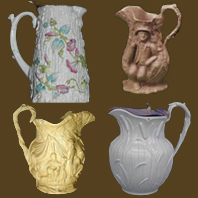Relief
Molded Stoneware Jugs
Defining Attributes
A thinly potted, highly vitrified stoneware with
complex molded designs covering virtually every vessel surface.
Vessel fabric can range from uniformly colored body pastes in
tan, pastel blues and greens to white-bodied stoneware sometimes
embellished with colored backgrounds, gilding, or enameled painting.
.jpg)
Chronology
Relief molded stoneware jugs decorated with complex
designs often depicting sentimental, floral, gothic, biblical,
or patriotic themes gained popularity in the early Victorian period
(Hughes 1985:9). These inexpensive but artistic vessels were manufactured
for the middle classes and produced in quantity beginning around
1830 and continuing through the 1870s (Henrywood 1984:50; Hildyard
2005:184; Hughes 1985:vi). They were used to serve a variety of
hot and cold liquids, including water, beer, milk, mulled ale
and wine.
Several characteristics—paste color, molded
motifs and jug shape—can be used in dating. Each trait is
discussed below.
Description
Fabric
 Relief molded stoneware jugs have a homogenous, fine grained,
highly-vitrified body. Many examples were stained to achieve a
uniformly colored paste. Jugs stained light blue, pale green,
olive green, tan, and, less commonly, lavender, generally date
earlier date than white jugs, which became the later standard
(Henrywood 1984:17). Relief molded jugs were also produced in
parian. Introduced in the early 1840s, parian was translucent
cream colored stoneware developed to imitate Greek Parian marble
(Barber 1967). Relief molded stoneware jugs have a homogenous, fine grained,
highly-vitrified body. Many examples were stained to achieve a
uniformly colored paste. Jugs stained light blue, pale green,
olive green, tan, and, less commonly, lavender, generally date
earlier date than white jugs, which became the later standard
(Henrywood 1984:17). Relief molded jugs were also produced in
parian. Introduced in the early 1840s, parian was translucent
cream colored stoneware developed to imitate Greek Parian marble
(Barber 1967).
Glaze
Relief molded stoneware jugs are most often smear glazed, a technique
in which a thin coating of glaze is applied, usually in the form
of a vapor (Lockett and Halfpenny 1982:109). Because smear glazes
are very thin, they help accentuate the molded detail.
Decoration
The chief decoration for these stoneware jugs was overall molding
in a variety of designs. The jugs were generally produced through
press molding, although slip casting was also used in the nineteenth
century for jugs produced in parian (Hughes 1985:5).
Molding covered virtually the whole surface
of the jugs, including elaborate handles and lips. Motifs varied
over time with changes in fashion, with some styles enjoying a
lengthy period of production and popularity, while others were
produced for only a decade or two.
Click
here to view a description of these two processes and how to determine
production methods.
The following date ranges and designs
were taken from Hughes (1985:11-13) and Henrywood (1984:30-32).
- 1830s and 1840s – Hunting and tavern scenes and mythological
themes in deeply molded relief. Often the lips and handles
are elaborately molded to represent human faces, dogs or other
animals, or plants.
(Click for example)
- 1840s and 1850s – Genre scenes, including countryside
activities such as harvesting crops, making wine or sleeping
children. (Click
for example)
Floral patterns remained popular throughout the
production span of relief molded jugs and can be broken down into
several dating categories. Henrywood (1984:31-32) divides these
categories into Running Plants, Growing Plants, Naturalistic Forms
and General Floral designs.
- 1830s-1840s—Running
Plants. The earliest plant designs were those whose branches,
leaves and flowers were irregularly scattered across the vessel.
Branches appear to sprout from the jug handle and plants typical
on these jugs included ivy, convolvulus, grapevines and hops.(Click
for example)
- Late 1840s—Growing Plants. Plants took on a more realistic
growth pattern, springing vertically up the sides of the jug
from the base. Typical plants include wheat, lilies of the
valley, tulips and thistles. (Click
for example)
- 1840s to the 1860s—Naturalistic Forms. Plants depicted
in great detail began to appear, often shown against an appropriate
background; for example, in Mayer’s Convolvulus pattern,
the jug is molded to represent a tree stump, against which
morning glories grow.(Click
for example)
- 1860s-1870s—General Floral. Price competition led
to simpler design and manufacturing standards. Stylized floral
patterns, often in conjunction with geometric designs, began
to appear.(Click for example)
- Beginning in the mid-1870s – Japanese-influenced designs
of random shapes and sprays of foliage and flowers, such as
cherry or prunus blossoms.(Click for example)
The quality and relief in molding also show general chronological
patterns. Beginning in the early 1830s and lasting for about ten
years, jugs depicted designs in crisp, deep relief (Hughes 1985:11).
In the 1840s, designs began to appear in more shallow relief and
continued into the 1880s, with a reduction in the quality of the
molding beginning in the second half of the century (Henrywood
1984:11). This decline was associated with overall trends in industrialized
mass production. Prices fell as potters undercut one another to
gain sales and market shares. Finding ways to make the jugs cheaper
was a means of increasing profit, but led to less visually desirable
products. By the 1860s, a stippled background was sometimes used
in conjunction with shallow relief designs (Hughes 1985).
Although sometimes embellished with enameled
paint, gilding, or a colored background, most vessels were not
decorated beyond the molded motifs. Around 1845, the use of colored
background slips became popular (Henrywood 1984:17). Blue and
brown backgrounds (and less commonly, orange, green, lavender,
pink and maroon) were popular. Often used with parian jugs, this
technique served to bring portions of the molded design into sharper
contrast. Gilding was sometimes applied to highlight vessel rims
or portions of the molded motifs. Beginning around 1860, multi-colored
painted designs were sometimes added to relief molded jugs (Henrywood
1984:17).
Form
Overall jug shapes, as described by Henrywood (1984: 27-28) and
Hughes (1985:11-12), provide a general dating tool.
-
1830s-1840s— Bulbous Form. A bulbous,
low-weighted body was widely used (Figure –a), becoming
more slender (Figure –b) in the later 1840s. Generally
round in cross-section, these bulbous jugs had pronounced
pedestal feet, flaring lips and high, molded handles. Smaller
foot rings and lower, less flaring lips appeared in conjunction
with the more slender jugs of the late 1840s.(Click
for example)
-
1830s onward—Modified Dutch Jug. Vessels with their center of gravity rising towards the shoulder
were present throughout the entire production period, with
a brief increase in the number of registered vessels in the
late 1840s and early 1850s. Vessel generally displayed small
foot rims and lower, less flaring lips. (Click for example)
-
Beginning in late 1840s—Tankard
Form. Characterized by a flat base with simple, straight sides
tapering towards the top of the vessel. Tankard-shaped jugs
initially continued the use of upward flaring spouts, later
replaced by flat rims.(Click
for example)
-
Mid to late 1850s onward—Baluster
Form. Beginning around 1850, but increasing later that decade,
potters adopted a shape characterized by a spherical lower
body on a small footring, tapering continuously to a flaring
spout. (Click
for example)
Click
here to view chart that depicts date ranges of
the four primary jug shapes from 138 registry marked jugs illustrated
in Hughes 1985 and 1991. Although the sample size is small, some
patterns do appear. Tankard and modified Dutch jugs appear consistently
throughout the range of production, although tankards first appear
in the 1840s. Bulbous form jugs appear at the beginning of relief
molded jug production and disappear in the 1850s. Baluster forms
appear in small numbers between 1840 and 1850, and then skyrocket
in the next two decades. The production of relief molded jugs
had slowed considerably by the 1880s.
Maker’s Marks
The bases of relief molded jugs are often marked
with an impressed or printed manufacturer’s name and a date
to register the design. Registry marks can be dated using tables
found in a number of ceramic reference books, including Geoffrey
Godden’s Encyclopaedia of British Pottery and Porcelain
Marks. Although Staffordshire was the primary center of production,
relief molded jugs were also manufactured in Yorkshire, South
Wales, Bristol, and Scotland. Prominent potters of relief molded
stoneware included William Ridgway and Co. (1830-1854), Charles
Meigh (1835-1849), Charles Meigh and Son (1851-1861), William
Brownfield (1850-1891), Samuel Alcock and Company (1828-1853)
and Copeland and Garrett (1833-1847).
References |




